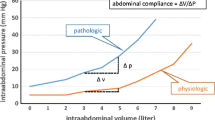Abstract
It is conceivable to view the peritoneal cavity as a separate and specialized compartment. Any events, which occur within this compartment are initially “compartmentalized,” but subsequently produce immense pathophysiological changes in the neighboring spaces and organs, and on the whole body as well. This review will focus on the local and systemic consequences of physical changes within the peritoneal compartment, caused by elevated intra-abdominal pressure and the pneumoperitoneum, which is induced during laparoscopic surgery. Intra-abdominal hypertension is yet another factor to consider in the overall management of the surgical and critically ill. Commonly it is relatively silent but contributing to patients SIRS, organ dysfunction and death. It may mimic sepsis and/or contribute to it. This old-new pathophysiological entity, which has been ignored for so long should be recognized, prevented and treated.
Similar content being viewed by others
References
Schein M, Wittmann DH, Condon RE. Hypothesis: Compartmentalization of cytokines in intra-abdominal infection. Surgery 1996;119:694–700.
Schein M, Wittmann DH, Aprahamian C, Condon RE. The abdominal compartment syndrome. J Am Coll Surg 1995;180:745–753.
Watson RA, Howdieshell TR. Abdominal compartment syndrome. South Med J 1998;91:326–332.
Sugrue M. Intra-abdominal pressure. Clinic Intensive Care 1995;6:76–79.
Cheatham ML. Intra-abdominal hypertension and abdominal compartment syndrome. New Horizons 1999;7:96–115.
Schein M, Rucinski J, Wise L. The abdominal compartment syndrome in the critically ill patient. Curr Opinion in Crit Care 1996;2:287–294.
Moore EE, Burch JM, Franciose RJ, Offner PJ, Biffl WL. Staged physiologic restoration and damage control surgery. World J Surg 1998;22:1184–1190.
Burch JM, Moore EE, Moore FA, Franciose R. The abdominal compartment syndrome. Surg Clin North Am 1996;76:833–842.
Eddy V, Nunn C, Morris JA Jr. Abdominal compartment syndrome. The Nashville experience. Surg Clin North Am 1997;77:801–812.
Nathens AB, Brenneman FD, Boulanger BR. The abdominal compartment syndrome. Can J Surg 1997;40:254–258.
Saggi BH, Sugerman HJ, Ivatury RR, Bloomfield. Abdominal compartment syndrome. J Trauma 1998;45:597–609.
Ivatury RR, Diebel L, Porter JM, Simon RJ. Intra-abdominal hypertension and the abdominal compartment syndrome. Surg Clin North Am 1997;77:783–800.
Sugerman HJ, Bloomfield GL, Saggi BW. Multisystem organ failure secondary to increased intraabdominal pressure. Infection 1999;27:61–66.
Sugrue M, Buist MD, Fourihan F, Deane S, Bauman A, Hillman K. Prospective study of intra-abdominal hypertension and renal function after laparotomy. Br J Surg 1995,82: 235–238.
Ivatury RR, Porter JM, Simon RJ, Islam S, Stahl WM. Intraabdominal hypertension after life threatening abdominal trauma: Prophylaxis, incidence, and clinical relevance to gastric mucosa pH and the abdominal compartment syndrome. J Trauma 1998;44:1016–1021.
Paul A, Troidl H, Peters S, Stuttmann R. Fatal intestinal ischaemia following laparoscopic cholecystectomy. Br J Surg 1994,81:1207.
Jaffe V, Russel RCG. Fatal intestinal ischemia following laparoscopic cholecystectomy (letter). Br J Surg 1994;81:1827–1828.
Dwerryhouse SJ, Melsom DS, Burton PA, Thompson MH. Acute intestinal ischaemia after laparoscopic cholecystectomy. Br J Surg 1995;82:1413.
Schorr RT: Laparoscopic upper abdominal operations and mesenteric infarction. J of Laparoendosc Surg 1995;5: 389–392.
Thiele H, Lang RD. Komplikationen nach 1000 laparoskopischen Cholecystektomien. Chirug 1994;65:795–800.
Diebel LN, Dulchavski SA, Wilson RF. Effect of increased intra-abdominal pressure on mesenteric arterial and intestinal mucosal blood flow. J Trauma 1992;33:45–49.
Caldwell CB. Ricotta JJ. Changes in visceral blood flow with elevated intraabdominal pressure. J Surg Res 1987;43: 14–20.
Eleftheriadis E, Kotzampassi K, Botsios D, Tzartinoglou E, Farmakis H, Dadoukis J. Splanchnic ischemia during laparoscopic cholecystectomy. Surg Endosc 1996;10:324–326.
Ishizaki I, Bandai I, Shimomura K, Abe H, Ohtomo I, Idezuki I. Changes in splanchnic blood flow and cardiovascular effect following peritoneal insufflation of carbon dioxide. Surg Endosc 1993;7:420–423.
Wallace DH, Serpell MG, Baxter JN, O'Dwyer PJ. Randomized trial of different insufflation pressures for laparoscopic cholecystectomy. Br J Surg 1997;84:455–458.
Hein HA, Joshi GP, Ramsay MA, Fox LG, Gawey BJ, et al. Hemodynamic changes during laparosocpic cholecystectomy in patients with severe cardiac disease. J Clin Anesth 1997;9:261–265.
McLauglin JG, Scheeres DE, Dean RJ, Bonnell BW. The adverse hemodynamic effects of laparoscopic cholecystectomy. Surg Endosc 1995;9:121–124.
Ho, Sauders CJ, Corso FA, Wolfe BM. The effects of CO2 pneumoperitoneum on hemodynamic in hemorrhaged animals. Surgery 1993;114:381–397.
Greif WM, Forse RA. Hemodynamic effects of the laparoscopic pneumoperitoneum during sepsis in a porcine endotoxic shock model. Am J Surg 1998;227:474–480.
Wittmann DH, Schein M, Condon RE. Currentmanagement of secondary peritonitis. Ann Surg 1996;224:10–18.
Tehar MA, Dunn MM. Open peritoneal management in murine peritonitis. Am Surg 1990;56:451–454.
Fujimoto M. Experimental study on the effect of various types of peritonitis and elevation of intra-abdominal pressure on endotoxin absorption. J Jap Surg Soc 1989;90:1989–1999.
Evasovich MR, Clark TC, Horattas MC, Holda S, Treen L. Does pneumoperitoneum during laparoscopy increase bacterial translocation? Surg Endosc 1996;10:1176–1179.
Ipek T, Paksoy M, Colak T, Polat E, Uygun N. Effect of carbon dioxide pneumoperitoneum on bacteremia and severity of peritonitis in an experimental model. Surg Endosc 11982:432–435.
Sare M, Yesilada O, Gurel M, Balkaya M, Yologlu S, Fiskin K. Effects of CO2 insufflation on bacterial growth in rats with Escherichia coli-induced experimental peritonitis.
Bloechle C, Emmermann A, Treu H, Achilles M, Mack D, et al. Effect of a pneumoperitoneum on the extent and severity of peritonitis induced by gastric ulcer perforation in the rat. Surg Endosc 1995;9:898–901.
Bloechle C, Emmermann A, Strate T, Scheurlen UJ, Schneider C, et al. Laparoscopic vs. open repair of gastric perforation and abdominal lavage of associated peritonitis in pigs. Surg Endosc 1998;12:212–218.
Bloechle C, Strate T, Emmermann A, Schneider C, Mack D, et al. Gastric tonometry accurately predicts mortality in experimental peritonitis in both laparosocpic and conventional surgery. Langenbeck Arch Surg 1999;384:76–83.
Benoit J, Cruaud P, Lauroy J, Boutelier P, Champault G. Does laparoscopic treatment of abdominal infections generate bateremias? J Chir (Paris) 1995;132:472–477.
Dugue L, Fritsch S, Felten A, Gossot D, Colomer S, et al. Effects of on intraperitoneal insufflation on hematogenous seeding of abdominal infections. Preliminary results of an experimental study in rats. Ann Chir 1995;49:423–426.
Ozguc H, Yilmazlar T, Zorluoglu A, Gedikoglu S, Kaya E. Effect of CO2 pneumoperitoneum on bacteremia in experimental peritonitis. Eur Surg Res 1996;28:124–129.
Gurtner GC, Robertson CS, Chung SC, Ling TK, IP SM, Li AK. Effect of carbon dioxide pneumoperitoneum on bacteremia and endotoxemia in an animal model of peritonitis. Br J Surg 1995;82:844–845.
Schein M, Ivaturi R. Intra-abdominal hypertension and the abdominal compartment syndrome. Br J Surg 1998;85:1027–1028.
Author information
Authors and Affiliations
Rights and permissions
About this article
Cite this article
Schein, M., Klipfel, A. Local Peritoneal Responses in Peritonities—Clinical Scenarios I: Peritoneal Compartment responses and its clinical consequences. Sepsis 3, 327–333 (1999). https://doi.org/10.1023/A:1009861629215
Issue Date:
DOI: https://doi.org/10.1023/A:1009861629215




